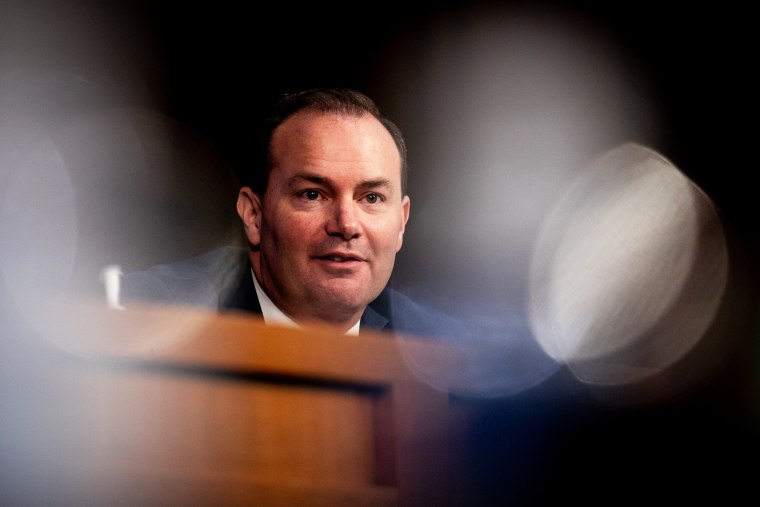Imagine this scenario: Parents learn via a Facebook post that three children in their elementary school of just 100 students are infected with Covid-19. They call the principal to find out whether their children are at risk, but their calls go unanswered; it is not made clear who will be interviewed by contact tracers or sent for testing, whether anyone is being quarantined or even who is in charge of investigating the situation. Eventually, the principal sends parents a note: The school will be open for anyone who wants to attend.
Few parents would accept that response. Yet a similar scenario is happening in the Senate on Monday, where the Judiciary Committee has convened in person to hold confirmation hearings for Supreme Court nominee Amy Coney Barrett after three senators tested positive for Covid-19 within the last 11 days. One of them — Mike Lee, R-Utah, who was reported to have tested positive Oct. 1 — is attending the hearing in person and without a mask, accompanied by a letter from the attending physician to Congress indicating that he had recovered and was no longer infectious.
However, other senators — particularly those on the Judiciary Committee who met with Lee on Sept. 30 and Oct. 1, during the period he was maximally infectious — are at risk for being contagious.
Of course, senators are not elementary school students. They and their staff members are at much higher risk for Covid-19 complications than young children in an elementary school are. How much higher is the risk? The average age of a senator is over 62, which means about half have expected mortality rates from Covid-19 more than 1,000 times higher than the rates for elementary school students.
We know that those three senators have been infected since the beginning of October, but there is little clarity about plans in the Senate for isolation, contact tracing or quarantine, let alone about how basic precautions like mask-wearing will be enforced. And the building was open for business Monday.
Guidelines from the Centers for Disease Control and Prevention for people who have tested positive for Covid-19, meanwhile, are straightforward. People with mild to moderate cases — such as those who are not hospitalized — should be isolated from others for at least 10 days from the onset of symptoms or a lab diagnosis; they may be released from isolation after 10 days if they have not had persistent fever or any other symptoms for at least 24 hours. This time period is based on data demonstrating how long infected people generally remain risks of infection to others. People with more severe symptoms might need to be isolated for longer, with the same precautions.
In addition to isolating for the recommended time, the CDC also recommends rapid contact tracing for newly infected people to prevent a major outbreak. That means that a public health team should retrace the steps of people who have received positive diagnoses starting two days before the onset of symptoms or the diagnoses, and those who had close contact with infected people should be instructed to quarantine away from others for two weeks. (This time period is based on data about the chance of harboring the virus after exposure before the disease manifests.) Quarantining cuts off the ability of the virus to spread to yet other people, and failing to do so raises the chance that more people will be infected.
Are these essential steps being followed in the Senate? To his credit, Ted Cruz, R-Texas, spoke remotely Monday because of his exposure to Lee. But it is not apparent that others who were exposed were contacted, traced or required to quarantine — leaving plenty of room for concern.
In the case of a school outbreak, the CDC recommends clear communication to address these sorts of questions. School leaders should send regular messages to teachers, staff members and families about the steps taken to respond to cases and the status of Covid-19 in the buildings. Senate leaders, however, do not seem to be communicating regularly about the situation and what is being done to protect senators, staff members, visitors, their families and other contacts; some senators have even resorted to proposing a resolution to establish a contact-tracing protocol.
Beyond the immediate risks to public servants on Capitol Hill, more and more attention has focused of late on the consequences of elected leaders' setting poor examples for the public by not following public health guidance about how to best prevent infections. We're now in a new phase, with elected leaders appearing to disregard public health guidance about how to respond to their own documented Covid-19 infections. If others follow suit, more and larger outbreaks are likely.
It is not too late for the senate to model a better response. Senators and others with Covid-19 should be isolated for as long as is necessary to protect public health, and their contacts should be identified and quarantined. Public health officials should provide regular and transparent updates — and determine the reopening of the Senate for in-person business when guidelines have been met and it is demonstrated to be safe to do so. In the meantime, senators should conduct their business remotely, just as many students and other nonfederal workers around the country are being forced to do.
Whether in the halls of an elementary school or the corridors of power in Washington, the coronavirus will keep spreading if we let it. The best way to stop the virus is to rely on science, transparency and leadership.
(The article expresses the views of the authors, not necessarily those of their institutions.)




